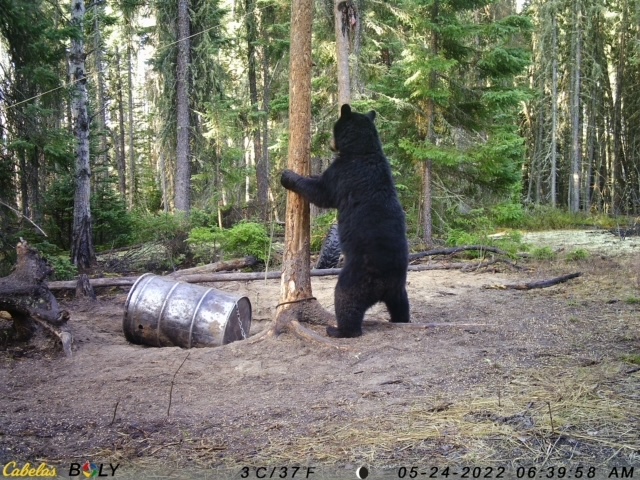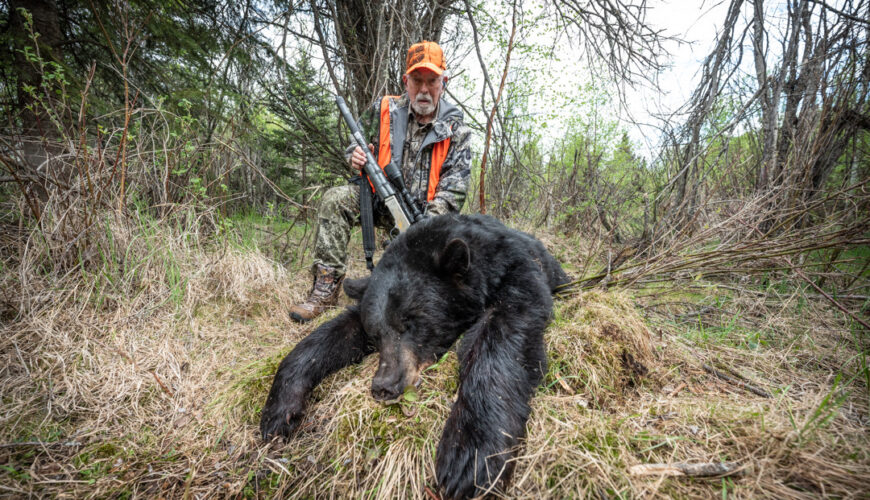Tactics
National Deer Association’s 5 Top Tips for Late-Season Deer Hunting
December 17, 2025 •iSportsman Staff
December 22, 2023
Irving Torchinsky waited patiently in his hunting stand, enduring the Canadian cold for a chance at hunting the bear. He managed to get there despite being 100% disabled, with no feeling whatsoever in the bottom of his feet — he’s learned to walk okay while keeping balance but says, “standing still is the most difficult.” The 84-year-old hunter held his Henry lever action .308 wildlife edition (a suitable replacement for a lefty who finds it nearly impossible to find a proper bolt-action) while watching the beavers hanging from the trees, all serving as bait for the bears. While it wasn’t the exact situation he had dreamed about when it came to hunting a bear, it was still better than he could have hoped for at this point in his life.
Cabela’s had invited him up to Saskatchewan for some sort of veteran’s hunt, though the specific reason eluded him. Regardless, he didn’t need to think much before deciding.
“I have no clue why they asked me, but I had 24 hours to say yay or nay, so I signed up and paid my money.”
Of all the people Cabela’s could have picked for this hunt, Irving Torchinsky was perhaps the most deserving. After developing a love for hunting at a young age thanks to his father, he joined the military at 20 — but this meant Irving wouldn’t get the chance to fully devote himself to hunting until he was well into retirement.
But what happened to Irving in the meantime was fascinating: learning how to dive from a world-renowned diver and documentary filmmaker, training for emergency services with Navy Frogmen, touring in Vietnam as a plane engineer, working in Saudi Arabia while spearfishing and exploring underwater photography, and more. It was only after all this that Irving would finally be able to add “taking down a bear” to his long list of accomplishments. It’s a list long enough to intimidate anyone, but it’s important to remember and one that deserves its own book to tell.
Irving Torchinsky started hunting at 16 years old when his dad took him while growing up in New York City. Back in those days Irving could carry a gun in the city, shooting at a range to practice for the times he went out for deer in the New York countryside. The experience of bonding with his father while testing himself against wild animals would inspire a love of hunting and a passion for nature that would stick with him for his entire life.
He was able to explore his love of the outdoors further when he joined the Air Force at 20 years old, but this increased opportunity to explore the world came at a cost: his hunting opportunities were severely limited. There weren’t as many hunting programs available back then for people in his situation.
Early in his military career, around 1958, Irving learned how to dive while operating with the British military off the coast of Libya, sparking his lifelong interest in the art of diving. Amazingly, his diving instructor was none other than Hans Haas, a famous diver, documentarian, and environmentalist who would help popularize ocean exploration and develop several innovations in diving technology. Additionally, Irving became one of the first hundred people to get a diving certification in L.A. County in 1960 after joining a local scuba club.

After this, Irving joined a rescue team while in California. They established the team to fill a void: there weren’t emergency services available as we know today. He trained with Navy Frogmen (the Navy SEALS wouldn’t be founded until 1962) and was on call along with the rest of the dive club for all emergencies pertaining to the ocean.
While he was able to get some hunting and sporting in during his stay in California, that quickly changed once he completed flight engineer school in 1964.
“Once I started flying, all sporting came to a halt; I was just travelling around too much.”
Once Irving trained as a C-130 flight engineer, he served three tours in Vietnam: 1967–1968, 1968–1970, and 1972–1975 (the end of the war). Unfortunately, he was a victim of the dreadful Agent Orange: It was his job to help carry 55-gallon drums of Agent Orange on and off planes, and he frequently had to push back a pallet full of them mid-flight to keep it in its correct spot through the plane ride. While he and the other service members helping with this task were afforded flight gloves designed to protect their hands, it wasn’t long before spillage caused by general flight turbulence saturated the gloves and soaked through to the skin. While it was terrible, others were even less fortunate.

Irving said: “Other guys were in even worse shape than I was, the ones who were emptying the drums and in charge of spraying it — they had the worst of it. We just came in contact with it as cargo, jammed in an airplane.”
Towards the end of the war, Irving was on one of the very last C-130 aircraft flying out of Vietnam during Operation Babylift, where he assisted in evacuating thousands of orphaned infants and children to be adopted by families around the world.
Irving got an assignment in England afterwards and, although he thought he might be able to get back to hunting and fishing, found no place to do so where he was stationed. After a few years, Irving retired from military service in 1983, around the age of 40.
With his military career behind him, Irving looked for ways to use his skills in the private sector. He found the perfect fit in Saudi Arabia putting his aeronautical engineering skills to use at Lockheed Martin, who operated a historic business in the area. He lived in Saudi Arabia in this capacity from 1983–1989 but was once again frustrated by the lack of hunting opportunities and inconvenient fishing conditions. While the area permitted angling, boats were not allowed to fish.
Fortunately for Irving, he had the perfect solution: diving. Thanks to this skill and passion, Irving could explore the local waters to his heart’s content and fish as much as he liked (albeit not from a boat). Over his six-year stay in the country, Irving found himself scuba diving, spearfishing, and doing underwater photography all the time to entertain himself. This brought him great joy in this foreign country, as he was able to easily befriend locals while sharing in his interests — he even started passing on his diving knowledge by teaching those that wanted to learn.

“Diving in the Red Sea was awesome; I had fantastic visibility and some great people to dive with,” Irving said. “I camped on the beach often, went out to reefs, and even became a scuba diving instructor while there — I taught local residents, with some of my students becoming instructors themselves, while making friends with local nationals.”
At the end of 1989 he moved back to America in Texas, where he converted his newfound teaching skills into becoming an educator, but he couldn’t stay away from Saudi Arabia for long. He went back to the country after just a year in Texas and stayed there from 1990–1999, working for the Saudi Arabia national airlines.
After a long career in the military and the private sector of aeronautical engineering —in addition to the countless hours diving and spearfishing in the Red Sea — Irving Torchinsky fully retired in 1999. That’s when he settled down in both Arkansas and Texas, splitting his time between the two based on the season and his family.
It was only then, after he was fully retired, that Irving started getting back into hunting and fishing in a big way.
“I picked up hunting again when I was 77 because my friends went hunting and fishing,” Irving said. “The conditions got worse with my feet — I still did fishing but my hunting was limited to waiting in blinds.”
Fast forward to January 2022 when Irving got a letter from Cabela’s, asking him if he wanted to go hunting.
He drove from Arkansas to Saskatchewan himself — you see, it was just after the height of COVID, and this 84-year-old wasn’t taking any unnecessary chances with the airlines. While it was an “easy going and fabulous” drive, he did run into some issues at the border. Fortunately, Irving was able to resolve the issue without conflict.
Irving said, “Canadian customs was nice and polite, they said, ‘Sorry, you can’t carry a magazine with more than 10 rounds,’ so they took it with some paperwork and gave it back to me on my return.
After storing his pistol magazine and checking his rifle, he headed on to Saskatoon where he stayed for a night before driving to Mirror Lake for the hunt. While he got there five days early, the lodge had plenty of room to accommodate him in the meantime. He passed his time pleasantly in the coming days, fishing for northern pike and making friends with other hunters and the managers of the cabin, who were all very friendly.
When the day of the hunt came, the men working with Cabela’s placed the hunters into good areas that were overcome with bear opportunities. The plan was for everyone to head out into the stands for up to five days as they each waited for their chance at the big score. Irving knew he was chosen to be out there for a reason, and he was determined to make the most of the opportunity. So, when he had a clear view of a bear on the very first day, he seized the moment and took the shot.

But the bear took off, leaving Irving dismayed at his failure.
“When the bear took off as though he was stung by a bee, I thought, ‘How could I miss that shot?’” Torchinsky said. “I called the guys and said, ‘Don’t worry about him; I didn’t get him.’ But they told me I did get him.”

After the guides tracked a blood trail 50 yards into the forest, the confirmation call came in. Despite the successful kill, the guides didn’t want any of the hunters out of the stands until they could verify the safety of the area. To get the bear and transport him from where he landed, they had to chop away a lot of growth to get a four-wheeler in, as the bear was way too heavy for the men to lift themselves. In the end they had to tie a pole to the bear, pull it out with a winch, and then use a deck platform to raise the bear into the truck.
After all this work, they skinned and cleaned it in their shed and then weighed it: 350 pounds.
“It was one of the largest bears for that hunt and year.”
It was impressive; especially so for a disabled 84-year-old hunter who’s lived much more than the average person.
With the bear hunt a success, Irving had nothing but praise for the guides and the sport of hunting.
“Cabela’s was very considerate of me, especially considering that I’m handicapped and can’t walk any real distance,” Irving said. “They appreciated that they had an 84-year-old on the hunt — and that’s the thing, being an old man still hunting. I still enjoy it and want to continue next season if I’m still around.”
